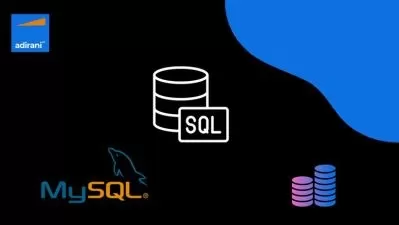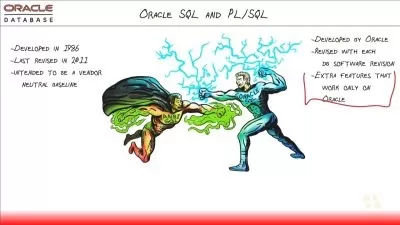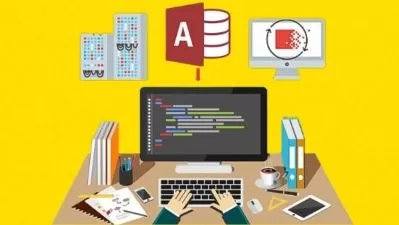SQL Mastery: Beginner's Guide to MySQL Essentials
Raghvan Bhattacharya
2:24:43
Description
MySQL basics booster for beginners
What You'll Learn?
- MY SQL WorkBench
- My SQL Commands
- My SQL database creation
- My SQL Constraints
Who is this for?
What You Need to Know?
More details
DescriptionCourse Overview: This course is designed to provide beginners with a solid foundation in MySQL, a widely used open-source relational database management system. It's a course for absolute beginners only.
What is MySQL?
MySQL is a relational database management system (RDBMS) developed by Oracle that is based on structured query language (SQL).
A database is a structured collection of data. It may be anything from a simple shopping list to a picture gallery or a place to hold the vast amounts of information in a corporate network. In particular, a relational database is a digital store collecting data and organizing it according to the relational model. In this model, tables consist of rows and columns, and relationships between data elements all follow a strict logical structure. An RDBMS is simply the set of software tools used to actually implement, manage, and query such a database.
MySQL is open-source
Any individual or enterprise may freely use, modify, publish, and expand on Oracle’s open-source MySQL code base. The software is released under the GNU General Public License (GPL).
For MySQL code needing to be integrated or included in a commercial application (or if open-source software is not a priority), enterprises can purchase a commercially licensed version from Oracle.
Again, these options provide organizations with additional flexibility if deciding to work with MySQL. The public and community-based nature of open-source releases enriches MySQL’s documentation and online support culture, while also ensuring that sustained or newly-developed capabilities never stray too far from current user needs.
MySQL is easy to use
Though MySQL’s relational nature and the ensuing rigid storage structures might seem restrictive, the tabular paradigm is perhaps the most intuitive, and ultimately allows for greater usability.
In fact, MySQL makes many concessions to supporting the widest possible variety of data structures, from the standard but rich logical, numeric, alphanumeric, date, and time types, to more advanced JSON or geospatial data. Beyond mere data types and an expansive built-in feature set, the MySQL ecosystem also includes a variety of tools, easing everything from server management to reporting and data analysis.
Regardless of the RDBMS’s overarching architecture, users can invariably find a MySQL feature allowing them to model and codify data how they wish. MySQL remains one of the most straightforward database technologies to learn and use.
Prerequisites: No prior knowledge of databases or SQL is required for this course. Basic computer literacy and familiarity with working in a command-line interface or graphical user interface (GUI) is recommended.
Who this course is for:
- Absolute Beginners
Course Overview: This course is designed to provide beginners with a solid foundation in MySQL, a widely used open-source relational database management system. It's a course for absolute beginners only.
What is MySQL?
MySQL is a relational database management system (RDBMS) developed by Oracle that is based on structured query language (SQL).
A database is a structured collection of data. It may be anything from a simple shopping list to a picture gallery or a place to hold the vast amounts of information in a corporate network. In particular, a relational database is a digital store collecting data and organizing it according to the relational model. In this model, tables consist of rows and columns, and relationships between data elements all follow a strict logical structure. An RDBMS is simply the set of software tools used to actually implement, manage, and query such a database.
MySQL is open-source
Any individual or enterprise may freely use, modify, publish, and expand on Oracle’s open-source MySQL code base. The software is released under the GNU General Public License (GPL).
For MySQL code needing to be integrated or included in a commercial application (or if open-source software is not a priority), enterprises can purchase a commercially licensed version from Oracle.
Again, these options provide organizations with additional flexibility if deciding to work with MySQL. The public and community-based nature of open-source releases enriches MySQL’s documentation and online support culture, while also ensuring that sustained or newly-developed capabilities never stray too far from current user needs.
MySQL is easy to use
Though MySQL’s relational nature and the ensuing rigid storage structures might seem restrictive, the tabular paradigm is perhaps the most intuitive, and ultimately allows for greater usability.
In fact, MySQL makes many concessions to supporting the widest possible variety of data structures, from the standard but rich logical, numeric, alphanumeric, date, and time types, to more advanced JSON or geospatial data. Beyond mere data types and an expansive built-in feature set, the MySQL ecosystem also includes a variety of tools, easing everything from server management to reporting and data analysis.
Regardless of the RDBMS’s overarching architecture, users can invariably find a MySQL feature allowing them to model and codify data how they wish. MySQL remains one of the most straightforward database technologies to learn and use.
Prerequisites: No prior knowledge of databases or SQL is required for this course. Basic computer literacy and familiarity with working in a command-line interface or graphical user interface (GUI) is recommended.
Who this course is for:
- Absolute Beginners
User Reviews
Rating
Raghvan Bhattacharya
Instructor's Courses
Udemy
View courses Udemy- language english
- Training sessions 6
- duration 2:24:43
- English subtitles has
- Release Date 2023/07/31













